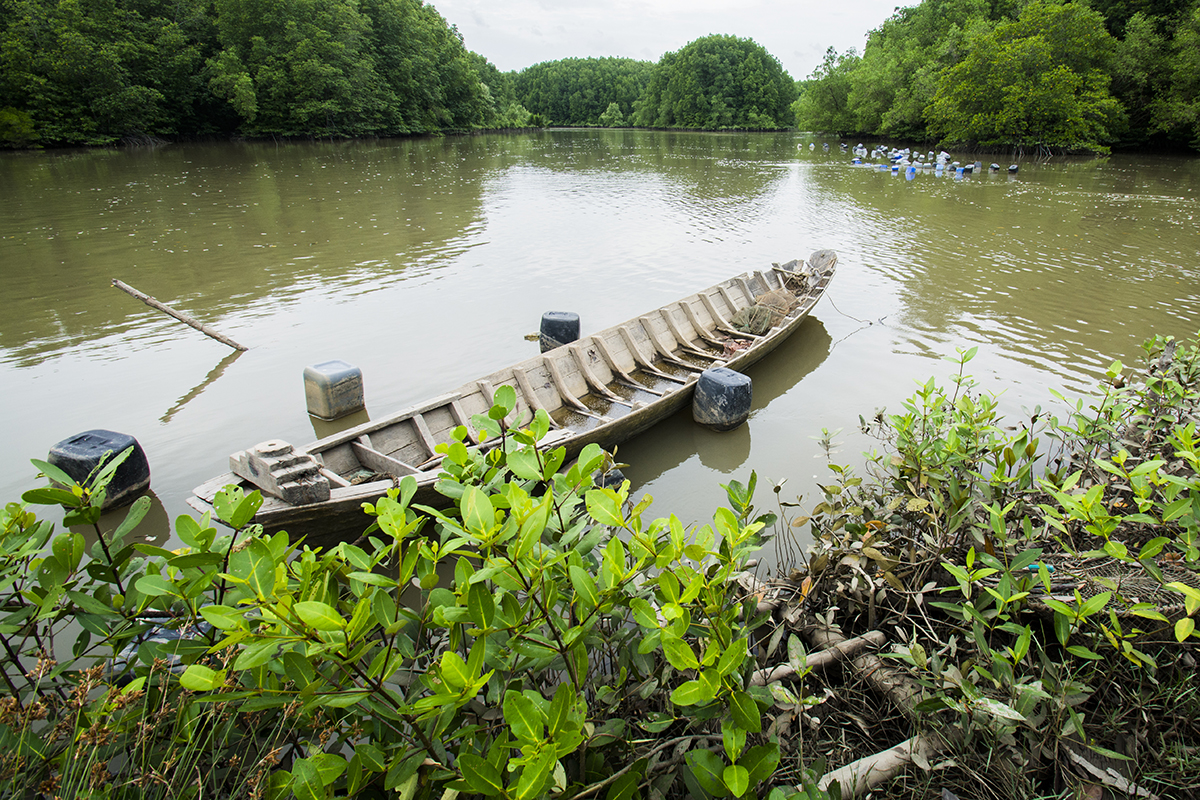Students Behind the Lens: Lione Clare
The Alaska native merges her passions for the environment and photography on a trip to Vietnam's Mekong Delta.
By Jenn Gidman
Images by Lione Clare
Lione Clare got her first point-and-shoot camera when she was 13, followed by an internship with a local news photographer, and she hasn't put down the camera since. The native of Sitka, Alaska, is now a student at the University of Montana, majoring in resource conservation and minoring in climate change (the environment is her other passion), and since her first photographic forays she's attended courses through Maine Media Workshops, won a North American Nature Photography Association High School Scholarship, and was even invited on a two-week photo safari to Tanzania in 2015. "There was a man who wasn't able to go on the safari, but he wanted to donate his spot to a young photographer, so the leader reached out to the NANPA president and I was recommended for it. It was the trip of a lifetime."
Her latest project, through a study-abroad program at her college, was a trip to Vietnam last winter. "Nine students went with the director of the climate change studies program," she says. "We traveled all around southern Vietnam, including the Mekong Delta, where climate change is impacting people, livelihoods, the environment, and agriculture. It's interesting, because we can expect similar challenges here in the US in the Mississippi Delta, one of the global connections I realized while working on this project. While I was there, I wanted to challenge myself to develop a photographic story around these concepts instead of just sharing single images."
Even though Lione didn't map out a photographic gameplan before she arrived at her destination, she had taken other wide-angle photos before in Alaska and realized she would need a solid wide-angle lens for Vietnam—and chose the Tamron 10-24mm. "I knew I wanted to create a story, and to do that, I was going to want to capture people in their environment," she says. "I didn't want to be restricted by the focal length and have to run back and risk missing shots. I went into the project with an open mind, and this lens enabled me to capture every type of image I wanted to put together a cohesive narrative."
That narrative started coming together as she took her photos and afterward, when she was going through them. "The four areas that organically emerged out of my images were food security, coastal forests, renewable energy, and migration," she says. "What ended up being the most challenging for me was reaching beyond my comfort zone. I'm used to taking landscape and nature photos in Alaska, but here I was in Vietnam photographing people, because I realized people were important to include in this story."
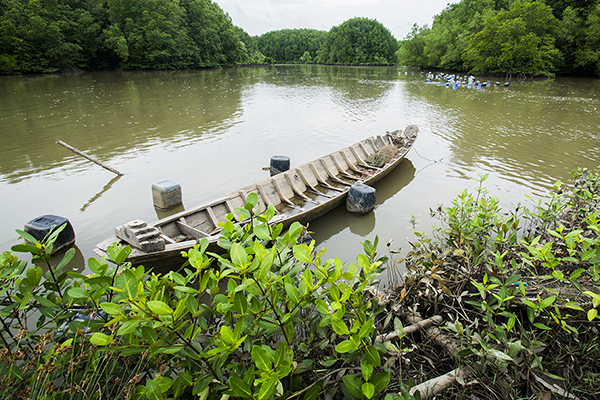
10mm, F/9, 1/160th sec., ISO 200
There was a shrimp farmer who lived within a bioreserve that Lione's group visited, and she snapped a photo of his boat while he broke for lunch. "He and his family live almost entirely off the land," she says. "Except for rice and a couple of vegetables in the dry season they have to get from the market, they live off what they grow. The three buckets you see are floats for oyster traps on the bottom of the river."
Unfortunately, at the time of day Lione visited the bioreserve, it was the wrong time for the tide, so she wasn't able to capture the farmer in his vessel checking the oyster traps or harvesting shrimp. But the 10-24 allowed her to not only photograph his boat in the foreground, but also all of the oyster traps in the background, filled with oysters and waiting to be emptied.
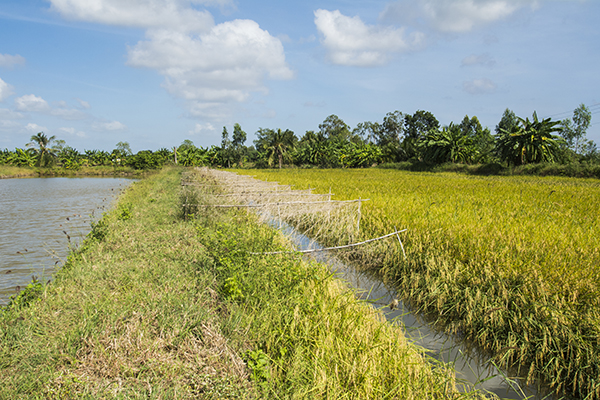
24mm, F/13, 1/250th sec., ISO 320
Saltwater intrusion is the main impact of climate change that's already causing sizable effects in Vietnam, with brackish floods affecting food security—especially rice farming. "Shrimp farming is therefore becoming more common, and fields that integrate both rice and aquaculture are becoming more common as an adaptation strategy," Lione explains.
The 10-24 allowed her to show this type of massive system in action. "The government has supported research to develop more salt-tolerant rice, so this is a system where the rice is growing in the wet season and then the trench cavity you see in this photo is where they raise the baby shrimp," she says. "They're eventually transferred over to the bigger pond on the left side of the photo. The shrimp can be useful during dry season, because they're more salt-tolerant than the rice, but this system lets them grow the shrimp and harvest the rice at the same time. I wanted to be able to show all the different parts in my image, which the 10-24 helped me do."
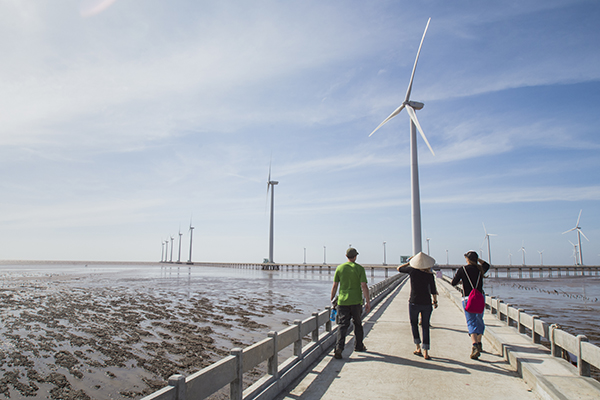
14mm, F/16, 1/250th sec., ISO 400
Lione and her team also visited a small-scale renewable energy biogas farm and an offshore wind farm in the Bac Lieu province, which is where she captured this next image. "There are currently 62 turbines (which they eventually hope to expand to around 100 turbines) that offset about 161,300 tons of C02 each year," she says. "The energy is then integrated into Vietnam's national grid to bring renewable energy to the majority of the country. I wanted to show the scope of how many turbines there were, but for a sense of scale, I waited until I could get some people in the photo. My instructor is in the middle wearing the traditional hat."
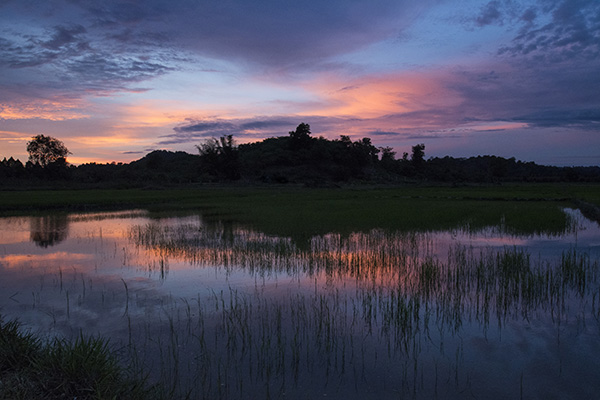
19mm, F/8, 1/30th sec., ISO 2500
An image of a ricefield at sunset made it into Lione's storyline because of its backstory. "Last year was the worst drought in 90 years in the Mekong Delta," she says. "As temperatures increase, there are more water shortages all around."
This particular photo was captured during a walk before dinner. "We stayed at a traditional longhouse just outside Cát Tiên National Park for one night, and during the day we walked into town, which was along a road that goes through all of these rice fields, to learn about the people in the village and their history. We were walking back to the longhouse when we came across this amazing sunset. It was a challenging photo for me in that it was a little brighter outside than I would've liked. I had to underexpose the image and then brighten the shadows a bit."
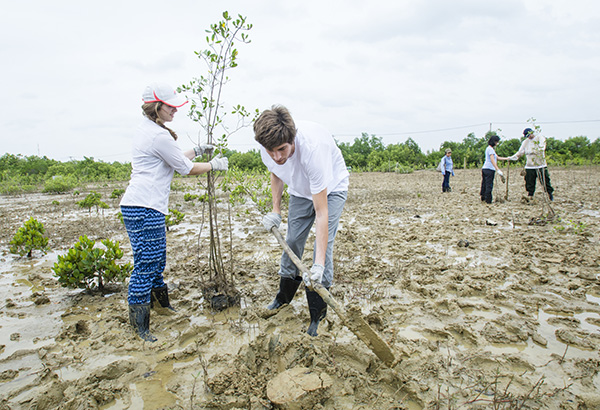
13mm, F/9, 1/400th sec., ISO 400
The mangrove forests in Vietnam serve a variety of purposes, from forest security and biodiversity to protecting the coastlines. "The tree roots anchor the sediment when storms sweep in, so they're vital, as storms are expected to increase in intensity with climate change," Lione says. In the same biosphere reserve as the shrimp boat, Lione and her fellow travelers helped restore these forests one morning by taking part in a mass planting.
"Tens of thousands of hectares of mangrove forest were destroyed during the Vietnam War when they were sprayed with chemicals," she says. "So this effort has been going on for some time, because they recognize the importance of the mangrove forests. We helped out on this particular morning by planting about 40 trees. The 10-24 lens helped me not only get close to my two main subjects, but also to show the expanse of the muddy fields and the other people who were also hard at work."
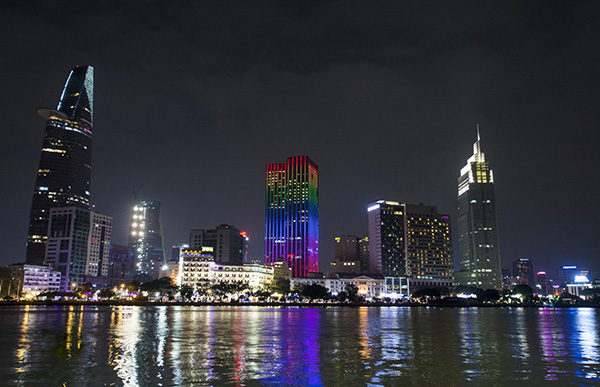
20mm, F/8, ½ sec., ISO 800
The major cities in Vietnam are seeing a migration influx, mostly from youth coming from rural areas in the Mekong Delta, abandoning agriculture for innovation, education, and work in services and industry. Lione notes that the migration will likely continue to increase as agricultural and living conditions become more challenged by climate change. "Ho Chi Minh City, formerly Saigon, is one of those rapidly developing cities in terms of population, development, entrepreneurship, youth culture, and business," she says.
After the rest of her group flew back home, Lione stuck around for three more days in the city, where she hung out with some of the people she'd met during her stay. "One guy named Koha ended up taking me all around on his motorbike, and we visited every district in the city," she says. "One evening we ended up across the river from the main part of the city, and we spotted this building lit up like every color of the rainbow. Koha was a photographer himself and had a tripod on him, so he lent it to me so I could capture this wide-angle scene of the cityscape with the rainbow building as the focal point. It took several tries to capture this image, because I wanted just the right exposure, and there were boats going by that I didn't want in the photo."
For other students looking for inroads into the photography field, Lione has one main piece of advice: Challenge yourself. "Expand your photography skills so you can enhance the skills you have," she says. "In my case, I was a nature and landscape photographer who suddenly was faced with trying to figure out people photography halfway across the world. I'm glad I took on that challenge, because it brought my skills and creativity to the next level."
To see more of Lione Clare's images, go to www.lioneclarephotography.com or follow her on Instagram @lioneclarephotography.
